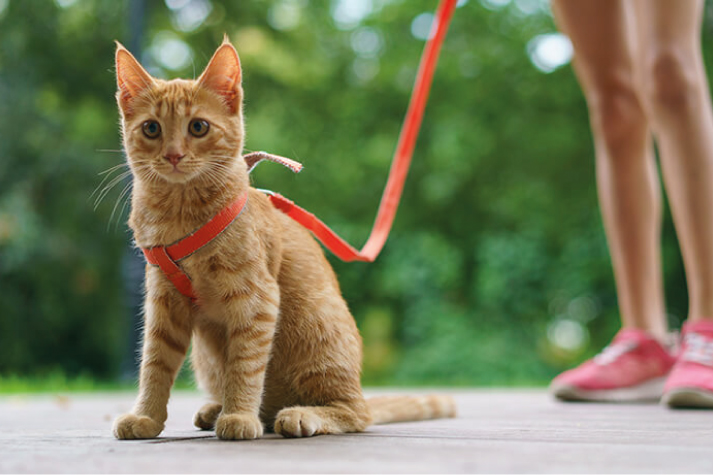
23 Oct
How to train Your Cat on a Leash and Harness
As people have started distinguishing between indoor and outdoor cats, there has
been renewed interest in the idea of leash/harness training a cat. It makes
sense, given how some outdoor cats who have been domesticated have an affinity
to sneak outside, or when you consider the fact that a modern pet parent wants
their baby along with them, all the time. The question then is, how to do so? It is notoriously difficult to train a cat to
do anything, let alone something as intimidating as walking on a leash while
wearing a harness. That being said, there are ways of making your cat
comfortable with a harness, so they can explore the great outdoors by your side.
A harness is also important for a cat due to their soft throats, in order to
prevent damage to them which may otherwise be caused by using a lead and collar
(like a dog). Now that your cat is comfortable with the presence of a harness, you can begin
working on training; specifically, training your cat to put the harness on of
their own accord. A cat harness typically connects in two places, at the neck
and at/around the waist. Once they are used to the harness being slipped on
their neck and allowing it, move on to the waist strap. While a cat may voluntarily put the harness around their neck (or allow you to
put it on them), getting it around its belly can often present a challenge. Cats
are protective of their bellies naturally, so there is no guarantee if a cat
will allow you to do a waist fastening, regardless of if you managed to get it
on their neck. If such a situation does present itself, it is crucial to desensitize them to
this as you did with the harness. Introduce it very slowly, and reward
independent and positive interaction with it. Gradually get the straps closer
and closer, day by day, until you can connect them without your cat feeling
uncomfortable or making a break for it. If your cat demonstrates restlessness or agitation at any point during the entire
process, step away and try again very, very slowly. All your work must occur
when your cat is comfortable and calm and on their own terms. Once you’ve successfully got a harness on your cat, another round of
desensitization follows. Your cat may freeze in position, or refuse to walk when
they wear it for the first time. This is normal and happens because your cat has
no prior experience of wearing a harness, so they are still adjusting to its
presence on its body. The process to make a cat comfortable with a harness on
its back is identical to the one used for putting on the harness. Leave the harness on, and if your cat is comfortable, reward them with treats and
affection. Take the harness off if your cat is agitated or irritated by it.
Repeat the process daily, and gradually, your cat will adjust to it. The process
remains the same for almost all behavioural conditioning. The main thing to remember is to keep calm, be patient, and that
learning/unlearning behaviour takes time. A patient and loving hand will be able
to condition almost anything in an animal; the onus is on you to be slow and
steady. The next step is to reward your cat for exhibiting the desired behaviour. Put the
harness on the ground, and if your cat interacts with it naturally (approaches
it, sniffs it, paws at it), reward them with a treat. If they do not approach
the harness themselves, place some treats on it and close to it. If your cat
then approaches it, reward them with even more treats. Repeating this is key; if
your cat has interacted with the harness, move it to the corner of the room, or
stow it away for a bit and then let them interact with it again. Repeat this
process a few times per day for a couple of days. Once your cat is naturally
curious about the harness when it is presented, or interacts with it by
themselves, then you are ready for the next phase. Now that your cat is comfortable with the presence of a harness, you can begin
working on training; specifically, training your cat to put the harness on of
their own accord. A cat harness typically connects in two places, at the neck
and at/around the waist. Once they are used to the harness being slipped on
their neck and allowing it, move on to the waist strap. While a cat may voluntarily put the harness around their neck (or allow you to
put it on them), getting it around its belly can often present a challenge. Cats
are protective of their bellies naturally, so there is no guarantee if a cat
will allow you to do a waist fastening, regardless of if you managed to get it
on their neck. If such a situation does present itself, it is crucial to desensitize them to
this as you did with the harness. Introduce it very slowly, and reward
independent and positive interaction with it. Gradually get the straps closer
and closer, day by day, until you can connect them without your cat feeling
uncomfortable or making a break for it. If your cat demonstrates restlessness or agitation at any point during the entire
process, step away and try again very, very slowly. All your work must occur
when your cat is comfortable and calm and on their own terms. Once you’ve successfully got a harness on your cat, another round of
desensitization follows. Your cat may freeze in position, or refuse to walk when
they wear it for the first time. This is normal and happens because your cat has
no prior experience of wearing a harness, so they are still adjusting to its
presence on its body. The process to make a cat comfortable with a harness on
its back is identical to the one used for putting on the harness. Leave the harness on, and if your cat is comfortable, reward them with treats and
affection. Take the harness off if your cat is agitated or irritated by it.
Repeat the process daily, and gradually, your cat will adjust to it. The process
remains the same for almost all behavioural conditioning. The main thing to remember is to keep calm, be patient, and that
learning/unlearning behaviour takes time. A patient and loving hand will be able
to condition almost anything in an animal; the onus is on you to be slow and
steady. Step 1 - Desensitization
Step 2 - Conditioning
Step 3 - Training






AUTHOR’S BIO
Carry My Pet
Passionate pet enthusiasts and globetrotters, dedicated to easing furry friends' journeys worldwide. Penning tales of compassion at CarryMyPet, where every relocation is a tail-wagging adventure.